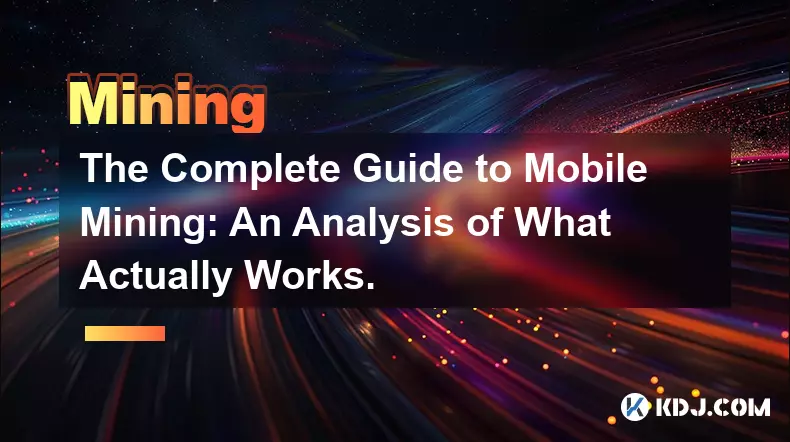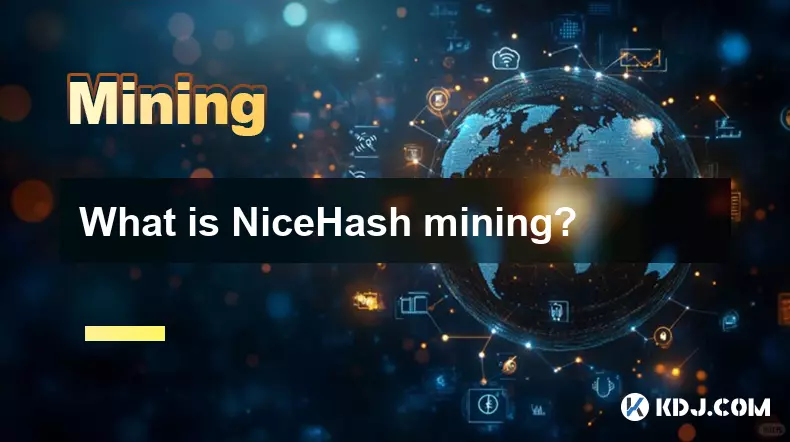-
 bitcoin
bitcoin $106680.127705 USD
0.67% -
 ethereum
ethereum $3615.722480 USD
-0.65% -
 tether
tether $0.999925 USD
-0.04% -
 xrp
xrp $2.550072 USD
5.91% -
 bnb
bnb $1002.572269 USD
-0.90% -
 solana
solana $168.746669 USD
1.08% -
 usd-coin
usd-coin $0.999832 USD
-0.03% -
 tron
tron $0.297244 USD
1.97% -
 dogecoin
dogecoin $0.182965 USD
0.71% -
 cardano
cardano $0.600432 USD
2.56% -
 hyperliquid
hyperliquid $41.439691 USD
-1.57% -
 chainlink
chainlink $16.548399 USD
2.40% -
 bitcoin-cash
bitcoin-cash $524.993680 USD
3.45% -
 stellar
stellar $0.302259 USD
4.10% -
 zcash
zcash $539.994871 USD
-16.31%
The Complete Guide to Mobile Mining: An Analysis of What Actually Works.
Most mobile "mining" apps don’t mine real cryptocurrency—instead, they simulate earnings, drain battery, and profit from ads, not user returns.
Nov 05, 2025 at 01:39 pm

Understanding Mobile Mining in the Cryptocurrency Ecosystem
1. Mobile mining refers to the process of using smartphones or tablets to mine cryptocurrencies, typically through applications downloaded from app stores. Unlike traditional mining that relies on powerful ASICs or GPUs, mobile mining leverages the processing power of handheld devices. This concept gained popularity due to its perceived accessibility and low entry barrier.
2. Most mobile mining apps do not perform actual blockchain computations. Instead, they simulate mining activity, rewarding users with tokens or points redeemable for small amounts of cryptocurrency. These models often operate as pay-to-click schemes where earnings are minimal and heavily influenced by referral systems.
3. True cryptographic mining requires substantial computational resources and energy efficiency that current mobile hardware cannot support. The hash rates produced by smartphone CPUs are negligible compared to dedicated mining rigs. As a result, any real mining effort on mobile devices consumes more battery and data than it generates in value.
4. Some applications claim to utilize idle processing time for decentralized computing tasks linked to blockchain networks. While technically plausible, these platforms rarely offer transparent proof of work distribution or verifiable payouts. Users should approach such claims with skepticism unless backed by open-source code and audited infrastructure.
The reality is that most so-called mobile mining apps are designed more for user acquisition than actual mining returns.Popular Mobile Mining Apps: Separating Hype from Functionality
1. Applications like Pi Network have attracted millions of users by offering 'free' cryptocurrency simply for opening the app daily. However, the coins earned remain untradeable until the network reaches full mainnet deployment, which has been repeatedly delayed. There is no guarantee these tokens will ever hold market value.
2. StormX and similar reward-based platforms label their earning mechanisms as 'mining,' but they function more like affiliate marketing programs. Users earn micro-rewards for completing surveys, watching ads, or shopping online—activities unrelated to blockchain validation.
3. Bitcoin farming games found on Google Play and the App Store often mimic mining interfaces while functioning purely as ad-driven entertainment. Revenue comes from in-app purchases and advertisements rather than cryptocurrency generation.
4. A few niche projects attempt legitimate distributed computing models, such as utilizing mobile devices for rendering or scientific calculations. Even in these cases, payout structures are opaque, and transaction fees frequently outweigh rewards.
Most top-rated mobile mining apps generate income for developers through ads and data collection, not crypto mining profits for users.The Economic and Technical Limitations of Smartphone Mining
1. Modern smartphones use ARM-based processors optimized for energy efficiency, not sustained high-load computation. Running intensive algorithms drains batteries quickly and risks overheating, leading to thermal throttling that further reduces performance.
2. Electricity costs relative to output make mobile mining economically unviable. Even if a device could mine at peak efficiency, the electricity consumed would exceed the value of mined coins by orders of magnitude.
3. Internet data usage is another overlooked cost. Many apps require constant connectivity to sync with servers, contributing to data plan exhaustion without proportional gains.
4. Wear and tear on devices reduce resale value and increase replacement frequency. Users may end up spending more on hardware degradation than they could ever earn in digital assets.
From both technical and financial perspectives, smartphones lack the capacity to serve as viable mining tools in today’s competitive blockchain landscape.Frequently Asked Questions
Can I mine Bitcoin on my phone and get rich?No. The computational difficulty of Bitcoin mining makes it impossible to profit using a smartphone. Any app claiming otherwise likely operates as a scam or misleading advertisement.
Is Pi Network a legitimate form of mobile mining?Pi Network does not currently conduct real-time blockchain mining. It distributes non-transferable credits based on participation. Whether these will ever convert into tradable currency remains uncertain.
Are there any safe mobile mining apps available?While some apps are not outright fraudulent, nearly all fail to deliver meaningful earnings. Many collect personal data or bombard users with ads. Genuine decentralized computing apps exist but are rare and poorly documented.
Why do people continue downloading mobile mining apps?Psychological incentives such as gamification, social referrals, and the illusion of passive income drive adoption. Developers exploit the hope of easy wealth, even when outcomes are mathematically improbable.
Disclaimer:info@kdj.com
The information provided is not trading advice. kdj.com does not assume any responsibility for any investments made based on the information provided in this article. Cryptocurrencies are highly volatile and it is highly recommended that you invest with caution after thorough research!
If you believe that the content used on this website infringes your copyright, please contact us immediately (info@kdj.com) and we will delete it promptly.
- Cryptocurrencies, Long-Term & BlockDAG: Navigating the Future in 2025
- 2025-11-12 01:30:01
- Navigating Crypto Investment: The Rise of Super Platforms and Unified Ecosystems
- 2025-11-12 01:50:01
- Canton Network's Wild Ride: Price Dip, Exchange Listings, and What It All Means
- 2025-11-12 01:20:02
- Dogecoin's Dollar Dream: Can This Low-Cap Coin Actually Reach $1?
- 2025-11-12 01:10:02
- AI Tokens, SoftBank, and NVIDIA Stake: A New York Minute on Tech's Latest Moves
- 2025-11-12 01:45:01
- Mastercard, Humanity Protocol, and Private Finance: A New Era?
- 2025-11-12 01:10:01
Related knowledge

What is the block reward in mining?
Nov 06,2025 at 12:35am
Understanding Block Rewards in Cryptocurrency Mining1. The block reward is the incentive miners receive for successfully validating and adding a new b...

How do mining algorithms work?
Nov 06,2025 at 04:59am
Mining Algorithms and Their Role in Blockchain Networks1. Mining algorithms serve as the backbone of blockchain consensus mechanisms, ensuring that tr...

What is NiceHash mining?
Nov 06,2025 at 07:40am
NiceHash mining refers to the process of renting out computational power to individuals or organizations seeking to mine cryptocurrencies without owni...

Does an antivirus program affect mining?
Nov 05,2025 at 09:29pm
Understanding Decentralized Exchanges in the Crypto Ecosystem1. Decentralized exchanges (DEXs) operate without a central authority, allowing users to ...

What is the history of Bitcoin mining?
Nov 05,2025 at 08:15pm
Within the fast-moving world of cryptocurrency, new developments emerge daily, reshaping how investors, developers, and institutions interact with dig...

How is the energy consumption of mining justified?
Nov 05,2025 at 10:20pm
Energy Consumption in Cryptocurrency Mining1. The energy consumption associated with cryptocurrency mining has drawn significant attention from enviro...

What is the block reward in mining?
Nov 06,2025 at 12:35am
Understanding Block Rewards in Cryptocurrency Mining1. The block reward is the incentive miners receive for successfully validating and adding a new b...

How do mining algorithms work?
Nov 06,2025 at 04:59am
Mining Algorithms and Their Role in Blockchain Networks1. Mining algorithms serve as the backbone of blockchain consensus mechanisms, ensuring that tr...

What is NiceHash mining?
Nov 06,2025 at 07:40am
NiceHash mining refers to the process of renting out computational power to individuals or organizations seeking to mine cryptocurrencies without owni...

Does an antivirus program affect mining?
Nov 05,2025 at 09:29pm
Understanding Decentralized Exchanges in the Crypto Ecosystem1. Decentralized exchanges (DEXs) operate without a central authority, allowing users to ...

What is the history of Bitcoin mining?
Nov 05,2025 at 08:15pm
Within the fast-moving world of cryptocurrency, new developments emerge daily, reshaping how investors, developers, and institutions interact with dig...

How is the energy consumption of mining justified?
Nov 05,2025 at 10:20pm
Energy Consumption in Cryptocurrency Mining1. The energy consumption associated with cryptocurrency mining has drawn significant attention from enviro...
See all articles









































































